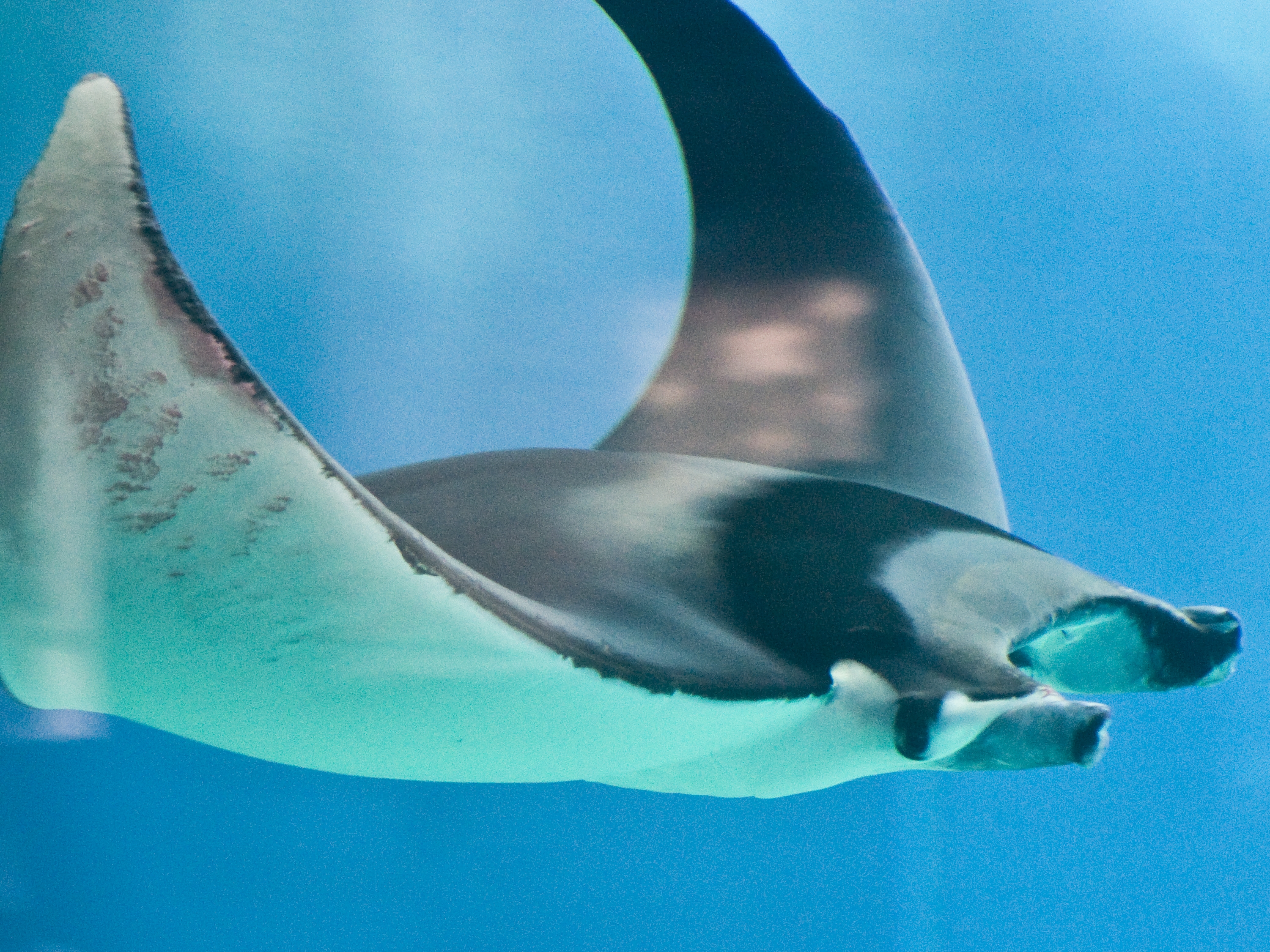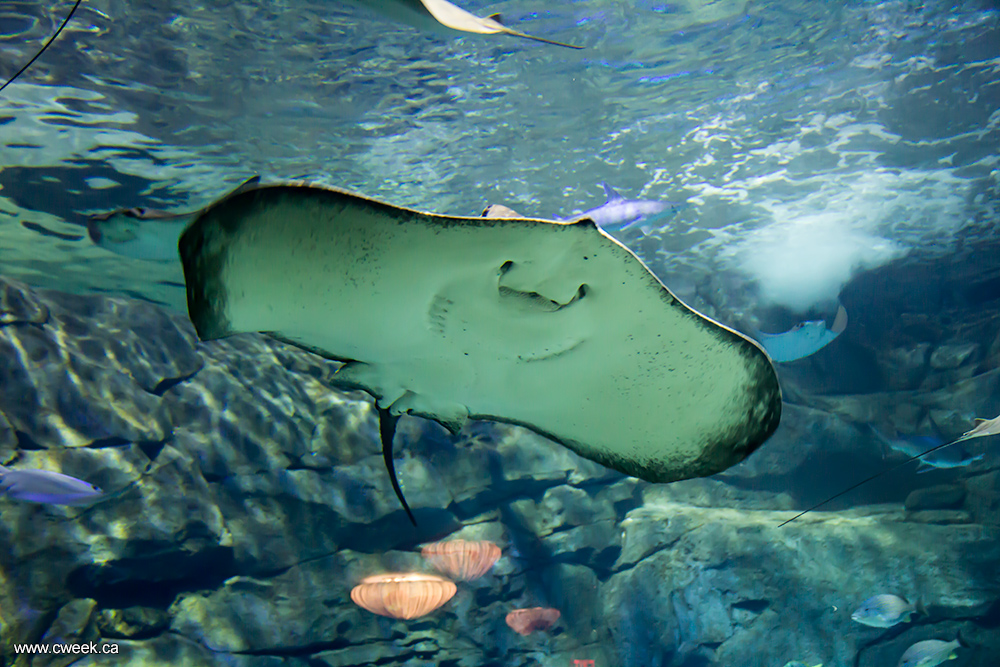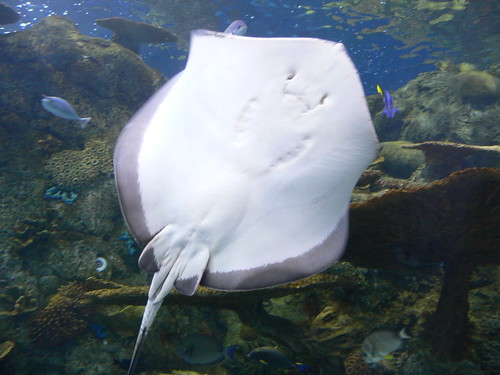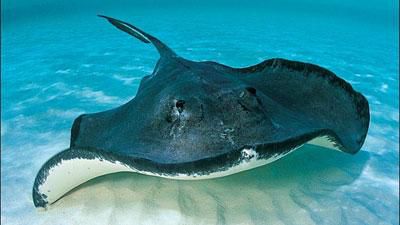Batoidea
Blaupunktrochen ( Taeniura lymma )
Rays ( Batoidea, Syn: Rajomorphii ) is a superorder of fish from the class of cartilaginous fish. With about 630 species, they provide more than half of the 1170 elasmobranch species.
Rays some species worldwide live in all seas, even in the deep sea. Skates and rays ( Rajidae ) and electric rays are in temperate seas species-rich, the other families in tropical. Few species of the family of stingrays ( Dasyatidae ) go in brackish and fresh water. In South America, the Potamotrygonidae live exclusively in the major streams and rivers of the continent.
In the North Sea, especially members of the Real skate ( Rajidae ) occur, the thornback ray (Raja clavata ), the starry ray (Raja radiata), the common skate (Dipturus batis) and the cuckoo ray (Raja naevus ). Other European species are the Common stingray ( Dasyatis pastinaca ), the marble - electric ray (Torpedo marmorata ) and the Atlantic torpedo (Torpedo nobiliana ).
Features
Rays have a strong, flattened bodies and large pectoral fins that are fused with the head. The shoulder girdle is annular and fixed or hinged to the spine. Some vertebrae are fused into a Synarcualia. The mouth, the nostrils, and five pairs of gill slits are located on the flattened mostly bright bottom. On the top there are eyes and the valved injection holes through which penetrates the water to breathe. The upper eyelid is firmly adherent to the eyeball. The top is adapted to the habitat of the skate, so it can range from beige to black speckled. The upper jaw, the palatoquadrate is not connected to the neurocranium, but is only supported by the large hyomandibular.
Nutrition
Most stingrays feed on hard-shelled invertebrates such as clams, crabs and echinoderms.
Locomotion
The primitive guitarfish and sawfish and the dither Roche -like move, like most sharks, snaking through stem of the body and the tail fin on. Skates and rays move their large pectoral fins undulating and eagle rays beat them like wings.
Reproduction
All Rays, lay with the exception of rights rays, the capsule-like eggs, are ovoviviparous, that is, the young hatch still in the mother's body or shortly after oviposition.
Outer systematics
The Rays have been traditionally regarded as of equal standing with the sharks taxon of cartilaginous fish. In 1996, the Neoselachii ( a taxon that modern sharks and rays comprises ) of de Carvalho and Shirai divided into two monophyletic taxa independently by morphological features, the Galeomorphii ( Galea at Shirai ), which mainly large, the open- water -dwelling sharks are assigned and the Squalea, which include many ground-dwelling and deep-sea sharks and the rays. The species of the sharks would thus be a paraphyletic ( a Formtaxon ), the Rays a subset of squalomorphen sharks.
In the meantime, however, there are several molecular studies that confirm a basal dichotomy of sharks and rays. The morphological similarities of squalomorphen sharks with the skates are then created convergent. Since the rays, as well as the modern sharks can be detected in the fossil record as early as the Early Jurassic, a derivation of the rays is not supported on the end of a long evolutionary line of Squalea of paleontological data.
Inside systematics
Skates and rays ( Rajidae )
Leg skate ( Anacanthobatidae )
Soft nose skate ( Arhynchobatidae )
Jitter Roche -behaved ( Torpediniformes )
Thorn back guitar sharks ( Platyrhinoidei )
Guitarfish I ( Aptychotrema, Trygonorrhina, Zapteryx )
Guitarfish II ( Rhinobatos )
Sawfish ( Pristidae )
Guitarfish III ( Glaucostegus )
Rhynchobatus
Round head guitarfish ( Rhina )
Zanobatidae
Six gill stingray ( Hexatrygonidae )
Deepwater stingrays ( Plesiobatidae )
Butterfly ray ( Gymnuridae )
Round stingrays ( Urolophidae )
Stingray ( Dasyatidae )
American round stingrays ( Urotrygonidae )
" Himantura " schmardae
Freshwater stingrays ( Potamotrygonidae )
Eagle rays ( Myliobatidae )
Kuhnasenrochen ( Rhinopterinae )
Devil Rays ( Mobulinae )
The Rajiformes to this order include most occurring in European marginal seas ray species are now divided into three families, all of the family of the Real skate ( Rajidae ) was formerly numbered. The second major Rochenklade combines the dither Roche -like, the guitar fish, the sawfish and the stingray -like, where the dither Roche -like, taking along with its sister group, the mandrel back guitar sharks ( Platyrhinidae ), a basal position within this clade, followed by a Kalde of three violin Roche genres. The remaining rays are divided into a clade of stingrays and sawfish, for Gavin JP Naylor and colleagues have proposed the new order Rhinopristiformes name, and in the stingray -like ( Myliobatoidei ) with its sister group, the monotypic Zanobatoidei. The sawfish are deep within a large Geigenrochenklade, with the violin genus of ray Glaucostegus as a sister group.
This concept of the relationship within the skate gives the following systematics:
- Order Rajiformes Family Skates and rays ( Rajidae )
- Family soft nose skate ( Arhynchobatidae )
- Family leg skate ( Anacanthobatidae )
- Family sleeper ray ( Narkinae )
- Family Narcinidae
- Family Pear electric ray ( Hypninae )
- Family torpedo ( Torpedinidae )
- Family thorn back guitar sharks ( Platyrhinidae )
- Violin family (Rhinobatidae )
- Family sawfish ( Pristidae )
- Subordination Zanobatoidei Family Zanobatidae
- Family Six gill stingray ( Hexatrygonidae )
- Family deepwater stingrays ( Plesiobatidae )
- Family round stingrays ( Urolophidae )
- Family Urotrygonidae
- Family stingrays ( Dasyatidae )
- Family freshwater stingrays ( Potamotrygonidae )
- Family butterfly rays ( Gymnuridae )
- Family eagle rays ( Myliobatidae )
Phylogeny
Rays from the originally existing as of the violin family (Rhinobatidae ) appear in the fossil record in the Upper Jurassic. The genera Aellopos and Asterodermus are known from the Solnhofen limestone. Another guitarfish is Rhombopterygia from the Upper Cretaceous of Lebanon. The recent violin Roche genera Rhinobatos, Trygonorrhina and Zapteryx are in the fossil record since the Lower Cretaceous and the Eocene.


2.jpg)

_(10574542184).jpg)





